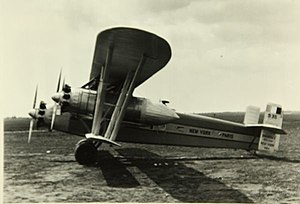Sikorsky S-35
| Sikorsky S-35 | |
|---|---|
 |
|
| Role | Transatlantic sesquiplane |
| National origin | United States |
| Manufacturer | Sikorsky Manufacturing Company |
| First flight | 23 August 1926 |
| Status | Destroyed |
| Number built | 1 |
The Sikorsky S-35 was an American twin-engined sesquiplane transport later modified to three-engines. It was designed and built by the Sikorsky Manufacturing Company for an attempt by Rene Fonck on a non-stop Atlantic crossing for the Orteig Prize. It was destroyed in the attempt.
The S-35 was designed as a twin-engined transport with a 1,000-mile (1,600-kilometre) range. During 1926 Rene Fonck, a French First World War fighter ace, was looking for a multi-engine aircraft to enter a competition to be the first to fly non-stop from New York to Paris. The prize was $25,000, offered by Raymond Orteig. Fonck had Sikorsky redesign the aircraft with three engines.
The S-35 was a sesquiplane with a fixed tailskid landing gear. It was modified to take three 425 hp (317 kW) Gnome-Rhône Jupiter 9A radial engines and fitted with jettisonable auxiliary landing gear.These modifications took time to complete and the aircraft first flew on 23 August 1926 from Roosevelt Field. Sikorsky started a series of test flights but as none were at the maximum takeoff weight of 24,200 pounds (11,000 kg), Sikorsky wanted to delay the transatlantic crossing until early 1927, but the promoters of the flight would not accept a delay and the aircraft was prepared for the crossing.
The first transatlantic attempt was scheduled for the 16 September but was abandoned after the aircraft developed a fuel leak. The next available break in the weather was to be the 21 September and the aircraft was fueled during the previous night from 50 barrels of gasoline. When the aircraft was weighed it was found to be 4,000 pounds (1,800 kg) overweight. Fonck and his co-pilot Lt Lawrence Curtin of the United States Navy were joined by a radio operator and a Sikorsky mechanic for the flight. In front of a large crowd at Roosevelt Field the aircraft gathered speed, the auxiliary landing gear broke away, the aircraft failed to get airborne and plunged down a steep slope at the end of the runway and burst into flames. The two pilots escaped injury but the radio operator and mechanic were killed, the aircraft which had cost $80,000 was not insured.
...
Wikipedia
